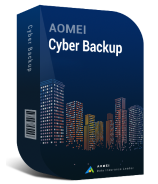What Is Archive Bit in Incremental Backup
Archive Bit in incremental backup is a file attribute that indicates whether a file has been modified since the last backup. The Archive Bit is a single binary value, typically stored as part of a file's metadata. It is used by backup software to determine which files need to be backed up during an incremental backup process.
Types of Backups:
● Full backup: The most basic and comprehensive backup method, where all data is sent to another location.
● Incremental backup: Backs up all files that have changed since the last backup occurred.
● Differential backup: Backs up only copies of all files that have changed since the last full backup.
How Incremental Archive Bit Works
Full Backup: When a full backup is performed, the Archive Bit is usually set to 1 for all files, indicating that they have been backed up. This means that every file is considered "archived" after the full backup.
Incremental Backup: After the full backup, during subsequent incremental backups, the backup software scans files on the source system. If the Archive Bit of a file is set to 1, it indicates that the file has been modified since the last backup. The software then backs up these modified files and resets the Archive Bit to 0 once the backup is complete. This signifies that the file has been "archived" again, i.e., it's been included in the backup.
By using the Archive Bit in this way, incremental backups become more efficient. Only the files that have changed since the last backup need to be included, saving time and storage space compared to a full backup where all files are backed up every time.
Incremental vs Differential Backup Archive Bit
The difference between incremental and differential backups lies in how they use the Archive Bit to determine which files to include in each backup.
✤ Incremental Backup:
Incremental backup includes files changed since the last backup. After the backup is complete, the Archive Bit of the backed-up files is reset to 0. Restore requires full backup and all incremental.
✤ Differential Backup:
The differential backup captures all changes since the last full backup, making it different from an incremental backup. Differential archive bit remains set after backup. Restore needs full backup and latest differential.
Incremental backups focus on recent changes since the last backup, while differential backups capture changes since the last full backup. Each approach has its advantages and considerations in terms of storage efficiency, restoration process, and backup chain complexity.
In Windows Server Backup, you can configure an incremental backup while setting up a scheduled backup.
How to Create Incremental Backup Using Robocopy with Archive Bit in Windows
Creating an incremental backup using the Archive Bit in Windows involves utilizing the built-in features. Robocopy (Robust File Copy) is a command-line tool built into Windows.
Here's a step-by-step guide on how to create an incremental backup using the Archive Bit:
1. Press Win + R, type "cmd", and press Enter to open the Command Prompt.
2. In the Command Prompt, navigate to the directory where Robocopy is located (usually C:\Windows\System32).
3. Use the following command syntax to perform an incremental backup using the Archive Bit:
- Replace SOURCE with the path of the source directory you want to back up.
- Replace DESTINATION with the path of the backup destination.
- The /MIR switch ensures that the destination will mirror the source, including deleted files.
- The /XO switch ensures that only files with the Archive Bit set to 1 (changed) since the last backup will be copied.
4. Press Enter and review the incremental backups.
Note: Make sure you have a destination where you'll store your backup files. You can backup windows to an external drive, network location, or cloud storage.
Efficient Incremental Backup Creation: Your Ultimate Guide
Incremental backup addresses the need to continuously back up data without duplicating unchanged files, thereby optimizing storage space and reducing backup time. With AOMEI Cyber Backup, you can efficiently implement incremental backups, safeguarding your data against unexpected threats and ensuring business continuity.
📢 Space Efficiency: AOMEI Cyber Backup intelligently tracks and backs up only the changed or new files, saving valuable storage space while ensuring data integrity.
🚩 Effortless Setup: AOMEI Cyber Backup offers a user-friendly interface, making it easy for both beginners and IT professionals to configure and manage incremental backups.
✍ Automated Scheduling: You can set up automated schedules for incremental backups, ensuring that your data is continuously protected without manual intervention.
🎈 Versatile Storage Options: AOMEI Cyber Backup allows you to store your incremental backups on a variety of destinations, including external drives, or network locations, giving you flexibility and redundancy.
1. Download and install AOMEI Cyber Backup and AOMEI Cyber Backup Agent on your physical servers/PCs.
2. Open AOMEI Cyber Backup web console and click Source Device >> Add Windows Device to bind your Windows Server.
3. Select Create New Task. You can select specific drives, files, partitions, or the entire system.
4. Specify the destination where you want to store the backup. This can be an external hard drive, network location, NAS or Amazon S3.
5. Set your preferred backup options for the incremental backup, including backup type (full, incremental, or differential) and define a backup schedule that suits your needs, whether it's daily, weekly, or another frequency.
6. Click the "Start Backup" button to initiate the backup process. AOMEI Cyber Backup will create a secure backup of your physical server based on your configured settings.
FAQ About Incremental Backup Archive Bit
Q: Are there any drawbacks to using incremental backups?
A: Yes, there is a potential drawback. Incremental backups rely on the archive bit, which can sometimes lead to issues if the archive bit is not properly managed. If the archive bit isn't reset after a successful backup, files might be backed up repeatedly, wasting storage space.
Q: Can I manually reset the archive bit?
A: Yes, you can manually reset the archive bit using various methods, such as backup software or command-line tools. This is often done after a successful backup operation to ensure that only newly changed files are included in the next backup.
Q: Is the archive bit used in all backup systems?
A: No, some modern backup systems use more advanced techniques like block-level tracking or change journaling to determine which files need to be backed up. The archive bit is still relevant in many legacy systems and smaller-scale backup solutions.
Q: How can I ensure the integrity of my incremental backup strategy?
A: Regularly test your backup and restore processes to verify that your incremental backup strategy is functioning as expected. Additionally, monitor backup logs for any unexpected behavior, and keep your backup software up to date.
Conclusion
Incremental backup Archive Bit was a historical approach to identify changed files. This article introduces the detailed steps of using the Archive Bit-based backup tool - Robocopy to create incremental backups in Windows, but considering contemporary backup solutions, modern backup method like AOMEI Cyber Backup is advisable for better data integrity, automation, and security.



